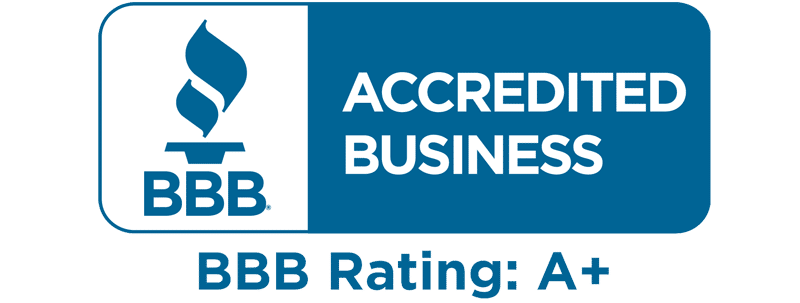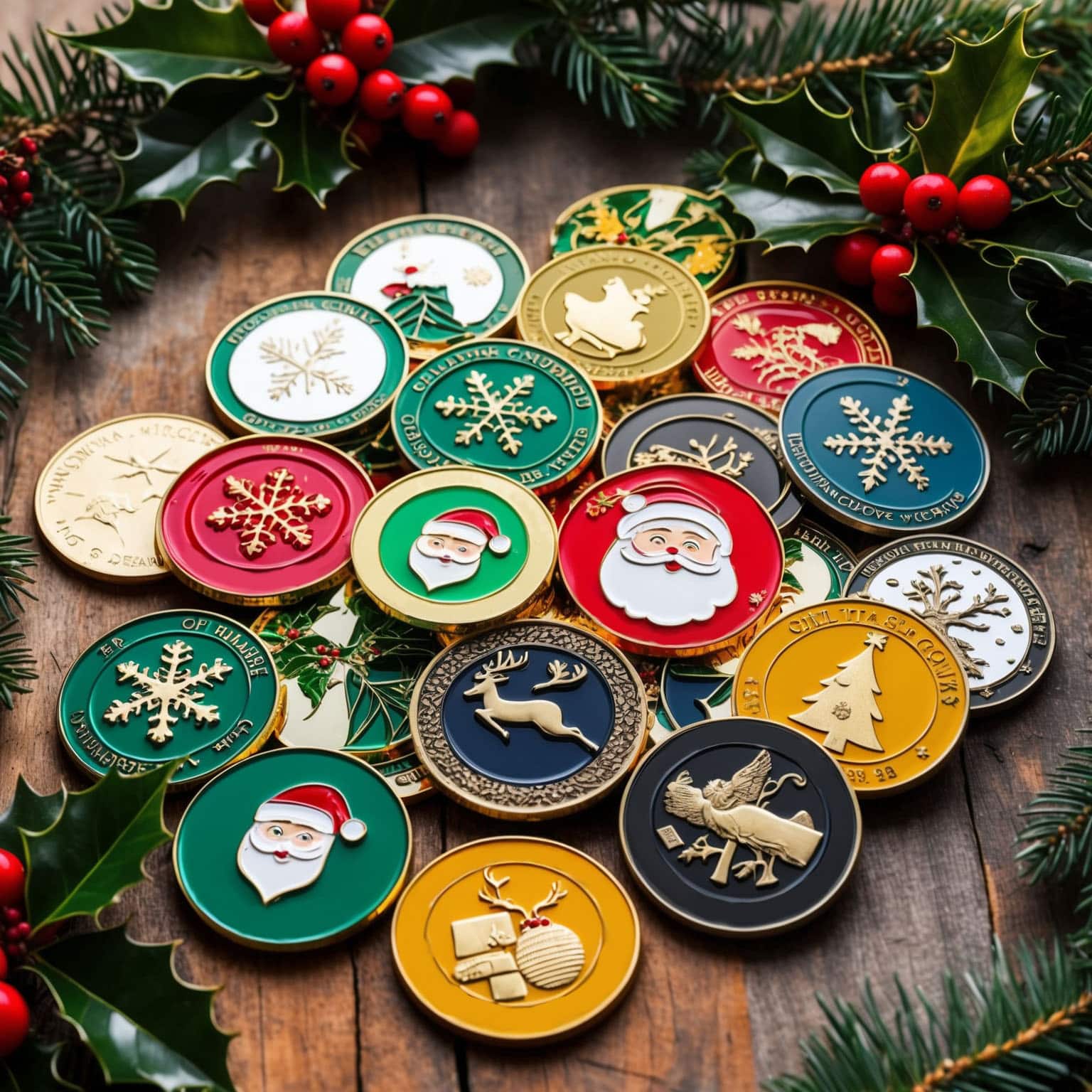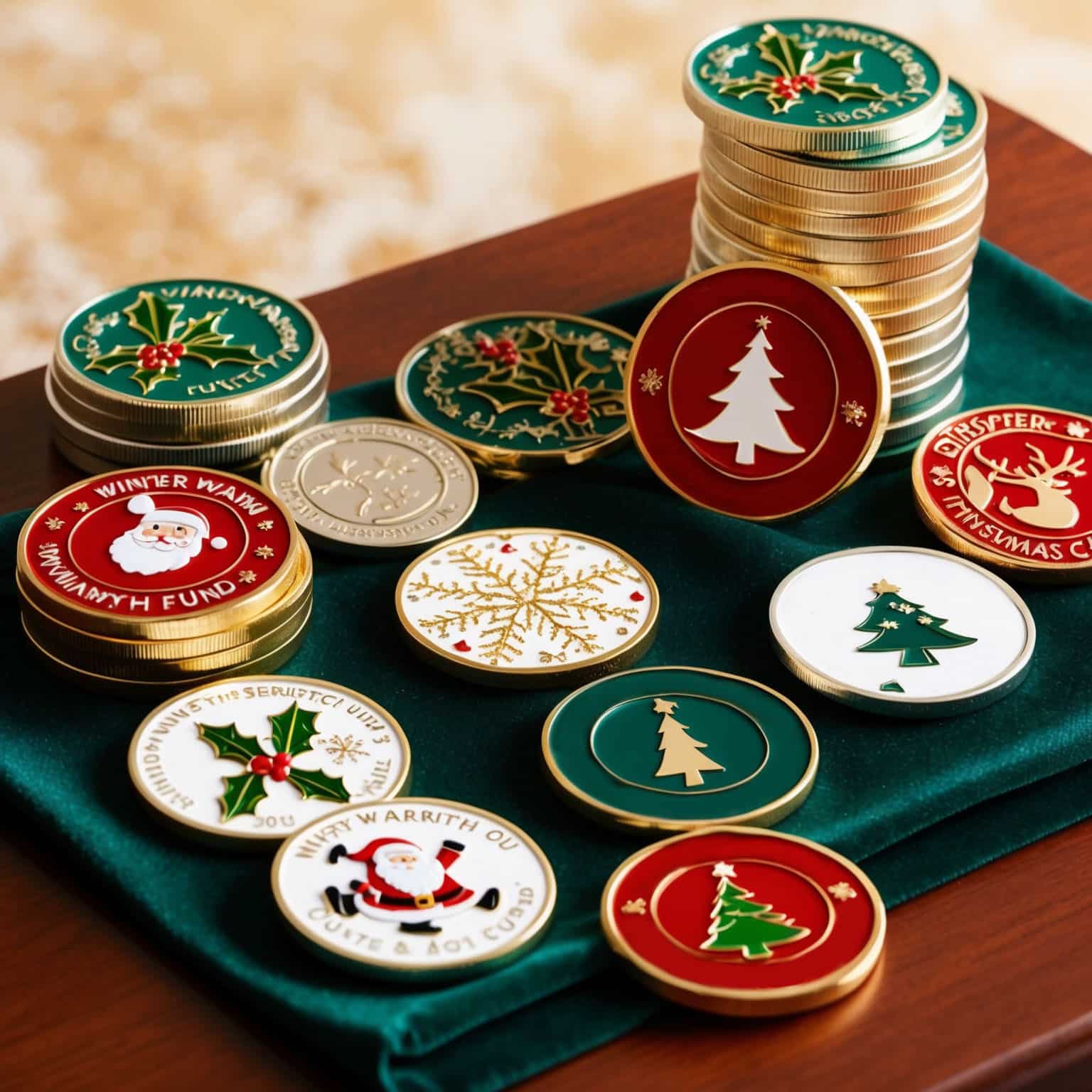Employee recognition is a vital component of a healthy workplace culture. It not only boosts morale but also increases productivity, fosters loyalty, and reinforces the values that drive a company forward. While there are many ways to recognize and reward employees, one particularly powerful method is through the use of impactful challenge coins. Originally rooted in military tradition, challenge coins have transcended their origins to become meaningful symbols of achievement, unity, and appreciation in the corporate world.
Creating impactful challenge coins for employee recognition programs requires thoughtful consideration of design elements, symbolism, and personalization. When done correctly, these coins can serve as lasting reminders of an employee’s contributions and as a powerful tool for reinforcing company culture and values. This comprehensive guide will provide you with essential tips for designing challenge coins that make a meaningful impact in employee recognition programs.
The Significance of Challenge Coins in Employee Recognition
Before diving into the design process, it’s important to understand the significance of challenge coins in the context of employee recognition. Challenge coins are more than just tokens; they are symbols that convey appreciation, honor achievements, and foster a sense of belonging among employees.
1. Rooted in Tradition
Challenge coins have their origins in the military, where they were used to build camaraderie, recognize service, and foster loyalty among soldiers. These coins often represented a unit or achievement and were carried with pride by members. Over time, the tradition of challenge coins expanded beyond the military to include law enforcement, public service, and eventually corporate environments.
2. A Symbol of Achievement and Belonging
In the corporate world, challenge coins have become a unique and meaningful way to recognize employees. Unlike traditional awards or certificates, challenge coins are small, portable, and can be carried with the recipient wherever they go. This portability makes them a constant reminder of the employee’s achievements and their value to the organization. Additionally, because challenge coins are often tied to specific teams, projects, or milestones, they help to foster a sense of belonging and unity among employees.
3. Enhancing Employee Morale and Engagement
Recognition is a powerful motivator. Employees who feel appreciated are more likely to be engaged, productive, and loyal to the company. By awarding challenge coins, employers can provide a tangible form of recognition that employees can cherish. These coins serve as a physical representation of the company’s appreciation and can be a source of pride for employees.
Practical Example:
An IT company awards custom challenge coins to employees who successfully complete major projects or achieve significant milestones. Each coin features the company’s logo, the project’s name, and the year it was completed. Employees proudly display their coins at their workstations, serving as a constant reminder of their accomplishments and the company’s recognition of their hard work.
Key Design Elements for Impactful Challenge Coins
Designing impactful challenge coins for employee recognition programs involves a careful balance of aesthetics, symbolism, and functionality. Below, we’ll explore the key design elements that contribute to creating challenge coins that are both meaningful and memorable.
1. Understanding the Purpose and Message
The first step in designing impactful challenge coins is to clearly define the purpose of the coin and the message you want to convey. Understanding the specific achievement, milestone, or value you want to recognize will guide the design process and ensure that the coin resonates with the recipient.
a. Purpose-Driven Design
Start by asking yourself what the coin is meant to represent. Is it to commemorate a specific achievement, such as reaching a sales target or completing a major project? Is it to recognize long-term service or exceptional performance? Defining the purpose will help you determine the appropriate symbols, imagery, and text to include on the coin.
Practical Example:
A retail company creates a challenge coin to recognize employees who exceed their sales targets for the year. The coin features an image of a sales graph with an upward trend, along with the words “Top Performer” and the company’s logo. The design clearly reflects the purpose of the coin and the achievement it recognizes.
b. Crafting the Message
Once you’ve defined the purpose, consider the message you want the coin to convey. This message can be communicated through text, symbols, and imagery. Keep the message clear and concise, ensuring that it aligns with the company’s values and the specific achievement being recognized.
Practical Example:
A healthcare organization creates a challenge coin to recognize employees who demonstrate exceptional patient care. The coin includes the words “Compassion in Action” along with the organization’s emblem and an image of hands holding a heart. The message reflects the organization’s commitment to patient care and the values it seeks to uphold.
2. Choosing the Right Symbols and Imagery
Symbols and imagery play a crucial role in the design of impactful challenge coins. These elements should be chosen carefully to reflect the company’s values, the specific achievement being recognized, and the overall message of the coin.
a. Company Logos and Emblems
Incorporating the company’s logo or emblem into the design is a common practice in challenge coin creation. This not only reinforces the connection between the coin and the organization but also adds a sense of authenticity and official recognition.
Practical Example:
A financial services firm designs a challenge coin for employees who achieve the prestigious “President’s Club” status. The coin features the company’s logo on one side, with the words “President’s Club” and the year on the other. The design ties the recognition directly to the company’s brand and prestigious award.
b. Symbols of Achievement
Including symbols that represent the specific achievement being recognized can make the coin more meaningful to the recipient. For example, a star might symbolize excellence, a torch could represent leadership, or a laurel wreath could signify victory and accomplishment.
Practical Example:
A manufacturing company awards challenge coins to employees who achieve perfect safety records. The coin features a shield and laurel wreath, symbolizing protection and achievement, along with the words “Safety Excellence” and the employee’s name. The symbols reinforce the importance of safety in the workplace and the employee’s contribution to maintaining it.
c. Imagery That Resonates
Imagery can be a powerful tool in challenge coin design, helping to tell a story or convey a specific message. When choosing imagery, consider what will resonate most with the recipient and align with the overall purpose of the coin.
Practical Example:
A technology company creates a challenge coin to recognize employees who contribute innovative ideas. The coin features an image of a light bulb, symbolizing innovation, with the words “Innovation Award” and the company’s slogan. The imagery aligns with the company’s focus on creativity and technological advancement.
3. Personalization for a Lasting Impact
Personalization is a key element of creating impactful challenge coins. By adding personal details, such as the recipient’s name, specific achievement, or a meaningful date, you can make the coin more significant and memorable for the recipient.
a. Engraving Names and Titles
Including the recipient’s name or title on the coin adds a personal touch and makes the recognition feel more individualized. This can be done through engraving or by incorporating the name into the overall design of the coin.
Practical Example:
A non-profit organization awards challenge coins to volunteers who have served for over five years. Each coin features the volunteer’s name, the organization’s logo, and the words “Dedicated Service.” The personalized engraving makes the coin a unique keepsake that honors the volunteer’s commitment.
b. Including Dates and Milestones
Adding dates or specific milestones to the coin helps to commemorate the exact moment or achievement being recognized. This can be particularly impactful for long-term service awards, project completions, or significant company anniversaries.
Practical Example:
A global consulting firm creates a challenge coin to celebrate its 25th anniversary. The coin features the company’s logo on one side, with the words “25 Years of Excellence” and the anniversary date on the other. The design commemorates the milestone and recognizes the contributions of employees who have been part of the journey.
4. Selecting the Appropriate Materials and Finishes
The choice of materials and finishes can significantly impact the appearance and feel of the challenge coin. Different materials offer varying levels of durability, weight, and aesthetic appeal, while finishes can add texture, color, and a polished look to the coin.
a. Material Selection
Challenge coins can be made from a variety of materials, including brass, copper, nickel, silver, and even gold. The choice of material will affect the coin’s durability, weight, and overall quality. For employee recognition programs, it’s important to choose a material that conveys a sense of value and prestige.
Practical Example:
A high-end retail brand creates a challenge coin made from antique brass to recognize employees who achieve top sales performance. The brass material gives the coin a solid, substantial feel, reflecting the value the company places on the achievement.
b. Finish Options
Finishes can add a layer of sophistication to the challenge coin, enhancing its visual appeal and protecting it from wear and tear. Common finishes include polished, matte, antique, and dual-tone finishes, each offering a different look and feel.
Practical Example:
A law firm designs a challenge coin for its partners, featuring a polished silver finish with gold accents. The dual-tone finish adds contrast and elegance to the coin, making it a standout piece that reflects the firm’s commitment to excellence.
5. Incorporating Texture and Detailing
Texture and detailing can add depth and dimension to the challenge coin, making it more visually interesting and tactile. Raised or recessed elements, 3D designs, and intricate engravings can all contribute to a more impactful and memorable coin.
a. Raised and Recessed Elements
Using raised or recessed elements in the design can create a sense of depth and texture, making the coin more engaging to look at and touch. This technique is often used to highlight specific symbols, text, or imagery.
Practical Example:
A telecommunications company creates a challenge coin for employees who complete a leadership development program. The coin features a raised image of a mountain peak, symbolizing achievement, with the program’s name engraved below. The raised and recessed elements add dimension to the design, making the coin more visually striking.
b. 3D Designs
Incorporating 3D designs into the challenge coin can add a sense of realism and complexity to the imagery. This technique is particularly effective for depicting detailed symbols or scenes that are central to the coin’s message.
Practical Example:
A defense contractor designs a challenge coin for its engineering team, featuring a 3D image of a satellite. The 3D design captures the intricate details of the satellite, reflecting the team’s technical expertise and contributions to the company’s projects.
6. Balancing Aesthetics and Functionality
While it’s important to create a visually appealing design, it’s equally important to ensure that the challenge coin is functional and practical for everyday use. This includes considering the size, shape, and weight of the coin, as well as how it will be carried or displayed by the recipient.
a. Size and Shape Considerations
The size and shape of the challenge coin will affect how it is perceived and used by the recipient. While larger coins offer more space for detailed designs, they may be less practical to carry. Conversely, smaller coins are more portable but may require simpler designs.
Practical Example:
A financial institution creates a standard-sized round challenge coin to recognize employees who achieve customer service excellence. The coin is small enough to fit in a pocket or wallet, making it easy for employees to carry and display it with pride.
b. Weight and Portability
The weight of the challenge coin should be considered, especially if the coin is meant to be carried by the recipient. A coin that is too heavy may be cumbersome, while a coin that is too light may not feel substantial. Finding the right balance is key to creating a coin that is both impactful and practical.
Practical Example:
A global shipping company designs a lightweight challenge coin made from aluminum to recognize employees who contribute to sustainability initiatives. The lightweight material makes the coin easy to carry, while the design reinforces the company’s commitment to environmental responsibility.
7. Ensuring Quality Craftsmanship
Quality craftsmanship is essential to creating an impactful challenge coin that will stand the test of time. This includes paying attention to details such as engraving precision, color application, and edge finishing. High-quality coins are more likely to be cherished and preserved by the recipient.
a. Precision Engraving
Precision engraving ensures that all text and imagery on the challenge coin are clear, sharp, and legible. This is particularly important for smaller coins or designs with intricate details. High-quality engraving reflects the care and attention that went into the coin’s creation.
Practical Example:
A luxury hotel chain creates a challenge coin for employees who deliver exceptional guest service. The coin features the hotel’s logo, the employee’s name, and the words “Excellence in Hospitality,” all engraved with precision to ensure clarity and readability.
b. Color Application
Color can be used to highlight specific elements of the challenge coin and make the design more vibrant and eye-catching. High-quality color application ensures that the colors are evenly applied, durable, and resistant to fading over time.
Practical Example:
A sports apparel company creates a challenge coin for employees who contribute to the launch of a new product line. The coin features the company’s logo in bright, bold colors, with the product line’s name and launch date. The high-quality color application makes the coin visually striking and memorable.
The Impact of Well-Designed Challenge Coins on Employee Recognition Programs
When designed thoughtfully, challenge coins can have a profound impact on employee recognition programs. These coins serve as powerful symbols of appreciation, reinforcing company culture and values while boosting employee morale and engagement.
1. Fostering a Culture of Recognition
Challenge coins play a key role in fostering a culture of recognition within the organization. By awarding coins for specific achievements, milestones, or behaviors, companies can reinforce the values and goals that are important to the organization. This, in turn, encourages employees to strive for excellence and take pride in their contributions.
Practical Example:
A tech startup introduces a challenge coin program to recognize employees who embody the company’s core values of innovation, teamwork, and customer focus. Each coin is tied to a specific value, with the employee’s name and the value they exemplified engraved on the coin. The program helps to cultivate a culture of recognition and reinforces the importance of the company’s values.
2. Boosting Employee Morale and Engagement
Recognition is a powerful motivator, and challenge coins provide a tangible way to show appreciation for employees’ hard work and dedication. When employees feel valued and recognized, they are more likely to be engaged, motivated, and committed to the company’s success.
Practical Example:
A pharmaceutical company awards challenge coins to employees who contribute to successful clinical trials. The coins feature the trial’s name, the company’s logo, and the words “Advancing Health.” The recognition boosts morale among the research team and reinforces their commitment to the company’s mission.
3. Reinforcing Company Identity and Values
Challenge coins can serve as a constant reminder of the company’s identity, values, and mission. By incorporating the company’s logo, motto, and other branding elements into the design, these coins help to reinforce the organization’s culture and the shared goals of its employees.
Practical Example:
A global logistics company creates a challenge coin for its “Safety First” initiative. The coin features the company’s logo, the words “Safety First,” and an image of a safety helmet. The design reinforces the company’s commitment to workplace safety and encourages employees to prioritize safety in their daily tasks.
4. Creating a Sense of Belonging and Unity
Challenge coins can help to create a sense of belonging and unity among employees, particularly when they are tied to specific teams, projects, or milestones. When employees receive a coin that recognizes their contributions to a shared goal, it fosters a sense of camaraderie and collective achievement.
Practical Example:
A financial institution creates a challenge coin for employees who contribute to the successful merger of two companies. The coin features the logos of both companies, along with the words “United in Success.” The coin serves as a symbol of the employees’ collective efforts and the successful integration of the two organizations.
5. Inspiring Continued Excellence
By recognizing and rewarding specific achievements, challenge coins inspire employees to continue striving for excellence. The coins serve as a tangible reminder of the company’s appreciation and the standards of excellence that are expected. This can lead to higher levels of performance, productivity, and job satisfaction.
Practical Example:
A marketing agency creates a challenge coin program to recognize employees who consistently exceed their targets. The coins feature the agency’s logo, the employee’s name, and the words “Exceeding Expectations.” The program inspires employees to continue delivering exceptional results and contributes to the agency’s overall success.
Mastering the Art of Designing Impactful Challenge Coins
Designing impactful challenge coins for employee recognition programs is both an art and a science. It requires a deep understanding of the company’s values, the specific achievements being recognized, and the elements that will make the coin meaningful and memorable for the recipient. By carefully considering the purpose, message, symbols, materials, and craftsmanship, companies can create challenge coins that serve as powerful symbols of recognition, appreciation, and pride.
Well-designed challenge coins have the potential to transform employee recognition programs, fostering a culture of appreciation, boosting morale and engagement, and reinforcing the values that drive the organization forward. As companies continue to seek innovative ways to recognize and reward their employees, challenge coins will remain a cherished and impactful tool for celebrating achievement and inspiring excellence.
Whether commemorating a significant milestone, recognizing exceptional performance, or fostering unity among teams, challenge coins are a timeless and meaningful way to honor the contributions of employees. By mastering the art of challenge coin design, companies can ensure that their recognition programs leave a lasting impact on their employees and contribute to a positive and thriving workplace culture.
If you are interested in a unique challenge coin, you can call us at 800-371-6256 or fill out a FREE quote form.








